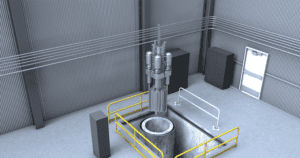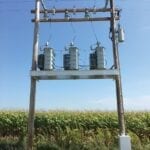
The demand for distributed generation (DG) solar has never been higher, yet many projects are getting stuck before they even break ground. The problem is utility interconnection. For community or net metered solar systems in the 1 MW to 5 MW range, in particular, the utility’s review of whether the grid can handle new power has become the defining step in the entire development process.
COMMENTARY
In theory, the process is straightforward. Engineers submit detailed electrical drawings, equipment specifications, and a site or roof plan to the utility. The utility reviews the local circuit and substation to confirm that it can safely accommodate the power. If the system can handle the generation, the project proceeds.
The reality is very different. I’ve seen clients line up land, secure financing, finish their engineering, and then sit in limbo. Depending on the state and utility, an interconnection review can take anywhere from nine months to four years. These delays reshape the economics of entire portfolios of DG projects. Owners lose interest. Incentive windows close. The finance community begins to doubt whether a project will ever reach construction and energization. Some developers eventually walk away.
Fortunately, new tools are emerging that can ease this bottleneck. Smart inverters and flexible interconnection strategies make it possible to connect projects more quickly and at lower cost, even on circuits that may appear constrained.
A Backlog with Structural Roots
There are several forces behind these slow-moving interconnection reviews, and many of them have little to do with the quality of a developer’s plans.
Recent state incentives have triggered a widespread land rush, especially in states with good community solar programs and incentives, where developers are tying up dozens of potential sites at once. Utilities must study every one of those applications and the existing circuits they will be added to. Many utilities simply were not designed or staffed to handle this surge, and so the backlog grows. Additionally, there are only specific times of the year some utilities put aside for this interconnection review process. Many do not want to add DG systems to their grid during peak usage seasons.
A second challenge, which may be controversial, is about incentives. Utilities make money by serving load, not by adding new sources of power. Major electricity consumers such as data centers or electric vehicle (EV) charging campuses are financially attractive. These projects often receive fast-tracked studies and even complimentary load flow analyses because the utility company is selling them power, and in the case of data centers, lots of it. A 5-MW solar project, on the other hand, does not buy power. It actually competes with the utility’s own sales, which creates little incentive to move quickly.
Any additional project costs can stop a project cold. When upgrades are required to accommodate new generation, utilities often assign the full expense to whoever happens to be first in line, even if many others will eventually use the same circuit. We have seen upgrade estimates of $5 million to $10 million placed on a single project. Some states now allow cost sharing, but many do not, and the financial burden routinely pushes otherwise viable projects out of reach.
At the same time, it is important to recognize that utilities are not acting out of hostility toward solar. Their first responsibility is to protect the stability and safety of their systems. Many utilities view flexible interconnection as a significant operational change, and utilities historically adopt new practices slowly. From their perspective, caution is tied to risk management and reliability, not simply an unwillingness to see more DG on the grid.
A More Adaptive Interconnection Model
The irony behind these huge utility upgrade costs is that this added generation is not seen on the system the vast majority of the time. Utilities are frequently requesting multimillion-dollar upgrades to address conditions that occur only a few days each year.
Flexible interconnection offers a practical way around this. The idea relies on modern smart inverters and distributed energy resource management systems, which allow utilities to dial back (or curtail) a solar project’s output when a circuit begins to approach its limits. Instead of reinforcing miles of utility infrastructure and updating outdated protection schemes, the utility can manage those rare peak moments by reducing output temporarily.
The technology is already a standard feature in most inverters. Many manufacturers now include “smart inverter” capabilities to meet IEEE 1547-2018 requirements, so the added cost is minimal. The key is control of the system, which allows the utility to send an automated signal that trims generation only when needed. The utility can provide dynamic reactive power support, modulate real power output as frequency deviates, and control ramp rates while protecting their systems with updated anti-islanding requirements, all on a standardized protocol. The options are endless for the utility to control the output of the photovoltaic (PV) plant and, on a micro level, the inverters.
For developers, the tradeoff is simple. A brief, occasional reduction in output is far easier to absorb than years of delay and multimillion-dollar upgrade bills. The approach already works in practice. One of our clients in Illinois agreed to a flexible interconnection arrangement more than two years ago, and the system has not been curtailed a single time since it went online.
This approach is relatively easy for developers to evaluate. Curtailment can be plugged into the same energy modeling software they already use, so they can see how much power they might actually lose over a year. In most cases, even the cautious estimates show that the impact on annual production would be small compared to the upgrade costs utilities often propose.
Rethinking Economics in the IRA Era
Some utilities remain reluctant to adopt flexible interconnection. Their hesitation often stems from internal issues, such as limited staff, outdated procedures, or unfamiliarity with new grid management tools. Yet the technology itself is already in place. Some utilities use similar systems to manage residential air-conditioning load during peak events, which means the shift to smart-inverter curtailment is more of an operational adjustment than a technical one.
That choice now matters more than ever. The Inflation Reduction Act (IRA) tightened the timeline for the federal tax incentives associated with solar development by requiring projects to show physical work by July 2026 to receive full incentives. In the past, long interconnection waits were frustrating but manageable. Under these conditions, those delays can undermine the entire financial structure of a project.
For developers, this makes early action essential. Applications should be submitted as soon as possible, and teams should ask upfront whether flexible interconnection is allowed and whether the utility supports smart-inverter curtailment.
A More Practical Grid for Distributed Solar
State policies will continue driving interest in distributed solar, even as federal incentives wind down. Whether those projects break ground will depend heavily on utilities’ willingness to adapt their interconnection practices.
At the same time, demand from data centers, electrification, and EV charging is rapidly increasing, putting new pressure on the grid. To manage these competing demands, utilities need more flexible tools. Smart inverters and flexible interconnection give them the ability to manage the rare peak moments that strain a circuit without paying for major infrastructure upgrades.
The future of solar growth now rests on how effectively new generation can be integrated into the grid we already have. Equipment improvements matter, but interconnection is the real gatekeeper. Smarter controls can cut costs, reduce delays, and help utilities manage real-time grid conditions. Traditional interconnection processes can no longer keep up with market demand. The technology to solve this is already available. What remains is the willingness to use it.
—Brian Poeltl, PE, is a senior electrical engineer and project manager at BL Companies working on renewable projects. He also trains staff engineers in PV system design.









